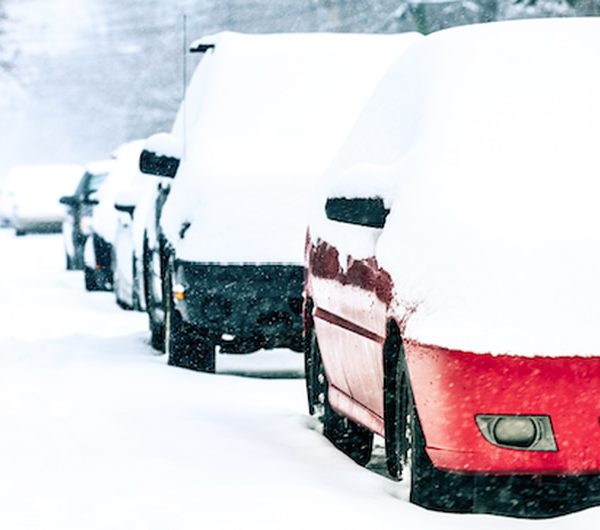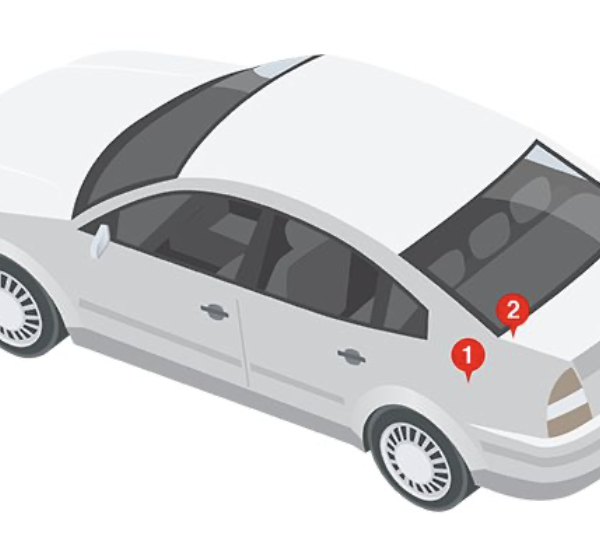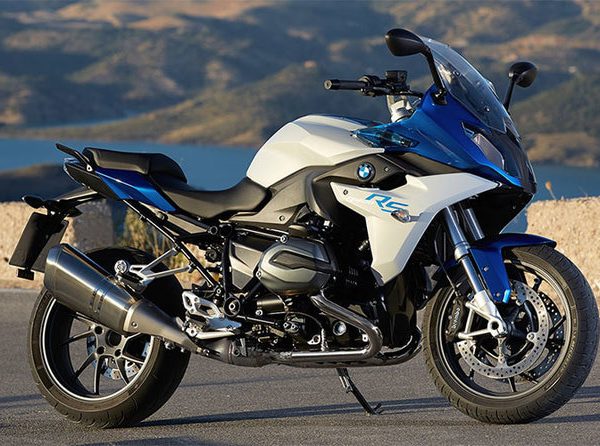Winterizing Your Car Inside and Out

Winter can wreak havoc on your vehicle. The evil trio of road salt residue, cold temperatures and dirt can affect your car or truck in a number of ways. Protecting your investment can enhance the safety of you and your passengers while keeping it looking and performing at its best for many seasons.
Attend to Your Brakes
You need your brakes to function optimally at all times of the year but no more so than during the winter season. In order to ensure that this is the case, monitor your brake fluid levels on a regular basis, and check brake pads and rotors for wear and tear, replacing them as soon as the need arises.
Watch Your Wipers
Heavy amounts of snow or ice can be very hard on your windshield wipers. To prolong their life, use a brush or scraper to remove snow or ice; don’t rely on your wipers for that purpose. If the weather forecast predicts a night of snow or freezing rain ahead, lift your wipers off the glass to prevent them from freezing in place by morning.
Finally, replace your wipers if you notice that they are leaving water streaks or are no longer performing at an optimal level. At the very least, winterizing your windshield wiper system should mean replacing your blades at least once a year and ensuring that your wiper fluid is topped off.
If you live in a part of the country where the winters are harsh, there are two other steps you can take. Consider buying a windshield washing solvent that has a lower freezing temperature. Also, look into purchasing winter wipers, which are made of a rubber material that prevents ice from collecting on them. Because winter wipers are heavier, they should not be left on year-round as they will burn out your motor.
Pay Attention to Your Vehicle’s Battery
When temperatures drop, so does your car battery’s ability to generate power. To illustrate this point, a typical LED-acid battery is at only half of its capacity at 5 degrees Fahrenheit. When you consider that your engine requires even more power than usual to get started on cold days, it becomes even more important to be confident in your battery.
There are some simple battery checks that you can perform yourself. Before you start the engine, turn on the headlights. If they get brighter when you start the car, it’s time to get an electrical check. You should also do so if your battery is more than three years old.
There are other steps you can take on your own as well. Be sure your battery terminals fit snugly and do not have any loose connections. Furthermore, your cables should be totally free of any cracks or breaks. Replace them if you see any problems. Remove the plastic cap or caps on the top of your conventional battery to look at the fluid level. If it’s low, add distilled water. If your battery is labeled as maintenance-free, check the window at the top of the battery to be sure it is fully charged. If you prefer to get help with maintaining your battery, ask your mechanic to run a battery load test and to remove any corrosion from your posts and connectors.
Don’t Forget Your Heater and Defroster
When the thermometer plummets, you want to be sure you and your family are toasty warm inside your vehicle. Therefore, it’s important to test your heater before the cold comes so that you can take corrective action if there is a problem. The same is true for your car’s defrosting system. In particular, you need to be able to see clearly out of your back window in snowy conditions. Consequently, be sure your rear-window defroster is working properly.
Fill Up More Often
Regardless of the calendar date, it’s always a good idea to keep your gas tank topped off, but this is particularly true in the winter. Having at least half a tank can protect you from gas line freeze-ups if the temperature drops. What’s more, keeping your engine – and heat – running if you get stranded might be the only thing that saves you and your passengers from becoming very uncomfortable until someone comes to your rescue.
Attend to Your Tires
When your tires are properly inflated, they will have maximum traction and contact with the road, factors that are extremely important in wintery, slippery conditions. One thing that many drivers don’t realize about winter weather is that the cold causes the air pressure in your tires to go down. For every 10 degrees, your tires will experience a decrease of 1 pound per square inch (PSI). A conscientious winterizing strategy should involve checking your tire pressure more frequently when the snow flies.
If your area gets a lot of snow, switching out your regular tires for snow tires is highly recommended. This is because snow tires are designed with tread patterns equipped for better stability on slippery surfaces. In addition, these tires are made from softer rubber that gives them more flexibility even in the coldest temperatures. Although they tend to generate more road noise and have a shorter tread life than all-season tires, these accessories are well worth the investment in terms of your safety.
Many drivers choose to mount their winter tires on steel wheels. Doing so makes it easier to swap one set of tires for the other. In addition, your pricier alloy wheels are thereby protected from the harshest of winter conditions.
Check Your Four-Wheel Drive
Four-wheel drive is one of the best weapons against difficult winter driving, so be sure yours is in tip-top shape while conditions are still mild. Visit your mechanic to have your transmission and gear fluids checked and topped off if necessary. Also, take a few minutes to re-familiarize yourself with the operation of your four-wheel drive system if you haven’t used it in awhile.
Be Sure Your Oil Makes the Grade
In most climates, modern multi-weight oil works well. However, consult your vehicle’s owner’s manual if you plan to be in an area with extreme temperature conditions. That’s because oil thickens in the cold, making engine operation more difficult. In the most extreme of conditions, you can purchase a block heater that attaches to the engine block or the oil pan, depending on the type of vehicle you have. This device plugs into a household outlet and keeps the temperature of the engine above 20 degrees Fahrenheit, enabling your oil to remain thin and move easily throughout the engine.
Don’t Forget About Your Exhaust System
Maintaining your vehicle’s exhaust system will enhance your fuel efficiency and safeguard the health of you and your passengers. Before winter comes, examine your exhaust pipes for crimps or leaks, replacing them if necessary. This can protect everyone in your car from carbon monoxide.
Stock Up On Emergency Supplies
If the worst happens and you’re stranded in your car, being prepared can literally save your life. Have these items on hand to maximize your chances of getting out of even the most uncomfortable situation unscathed:
- Fully charged backup cell phone
- Jumper cables
- Flashlight
- Bag of sand or kitty litter in case your tires get stuck in snow or slush
- Roadside flares
- Warm blankets
- Protein bars or other nonperishable food
- First aid kit
- Jug of water
- Ice scraper
- Tow strap
- Hammer to break a window in an emergency
- Portable air compressor to fill a leaking tire until you can get to a gas station.
Guard Against Being Frozen Out
Extremely cold temperatures can actually contract your door locks and prevent you from being able to use your key. It can even break when you try to insert it into the lock. Applying warm water is a tried and true cure for this problem, but it isn’t always available. For times like that, keep a tube of glycerin de-icer handy in a safe place – not your car – such as your desk and your garage. You can buy glycerin at most discount, hardware and auto parts stores.
Check Your Cooling System
The cold causes rubber to crack, and that includes the rubber that makes up your car’s radiator hoses. Squeeze your hoses to be sure they are pliable but firm, replacing them if they seem brittle, too soft, leaky or cracked.
The proportion of water to anti-freeze solution in your car’s cooling system should be about half and half. Maintaining it at this level keeps your radiator coolant from freezing. Fortunately, it’s easy and inexpensive to monitor these levels. You can purchase a testing kit at any auto parts store.
In general, you should flush out your cooling system once every two years to prevent the build-up of corrosion. It’s a good idea to perform this maintenance task before the onset of winter to keep your vehicle performing optimally.
Preserve Your Vehicle’s Interior
Water, mud and road salt residue can quickly turn the inside of your car into an unsightly mess. Even an inexpensive pair of floor mats will protect your carpet. Investing in all-weather rubber mats will do an even better job of shielding your interior and floorboards from damaging road salt and water.
Protect Your Vehicle’s Exterior
Salt, ice, snow and potholes can do a nasty number on the outside surface of your vehicle, but there are some things you can do to minimize the damage. Start by applying a coat of wax before the snow flies. Throughout the winter, wash your vehicle regularly to get rid of dirt and residue.
Although rust isn’t as much of an issue these days as it once was, it’s still important to wash the underbody and wheel wells. Waxing your alloy wheels can cut down on corrosion and pitting. Once winter gives way to the more temperate climate of spring, you can purchase some automotive touch up paint to reduce the appearance of any dings or minor scratches that might have come about during the cold months.
Get Regular Maintenance On Your Vehicle
Giving your car or truck a regular and thorough once-over is an essential component in ensuring that it is safe year-round, including in the winter. Whether you are a skilled professional and do it yourself or you consult a trained mechanic, make sure that someone looks over your spark plugs, fan belts and hoses to be sure that everything is in order. Taking preemptive steps such as this can protect you from very sticky situations that always seem to happen during the worst times and most inclement of weather conditions.
Before the mercury falls, you take steps to protect yourself and your family from the chill. For example, you buy warm clothing and check your household heating system. Be sure to give your vehicle the same thorough care. By doing so, you can drastically decrease the effects of the weather while enhancing your safety and the overall functioning and appearance of your vehicle.
Winter can wreak havoc on your vehicle. The evil trio of road salt residue, cold temperatures and dirt can affect your car or truck in a number of ways. Protecting your investment can enhance the safety of you and your passengers while keeping it looking and performing at its best for many seasons.
Attend to Your Brakes
You need your brakes to function optimally at all times of the year but no more so than during the winter season. In order to ensure that this is the case, monitor your brake fluid levels on a regular basis, and check brake pads and rotors for wear and tear, replacing them as soon as the need arises.
Watch Your Wipers
Heavy amounts of snow or ice can be very hard on your windshield wipers. To prolong their life, use a brush or scraper to remove snow or ice; don’t rely on your wipers for that purpose. If the weather forecast predicts a night of snow or freezing rain ahead, lift your wipers off the glass to prevent them from freezing in place by morning.
Finally, replace your wipers if you notice that they are leaving water streaks or are no longer performing at an optimal level. At the very least, winterizing your windshield wiper system should mean replacing your blades at least once a year and ensuring that your wiper fluid is topped off.
If you live in a part of the country where the winters are harsh, there are two other steps you can take. Consider buying a windshield washing solvent that has a lower freezing temperature. Also, look into purchasing winter wipers, which are made of a rubber material that prevents ice from collecting on them. Because winter wipers are heavier, they should not be left on year-round as they will burn out your motor.
Pay Attention to Your Vehicle’s Battery
When temperatures drop, so does your car battery’s ability to generate power. To illustrate this point, a typical LED-acid battery is at only half of its capacity at 5 degrees Fahrenheit. When you consider that your engine requires even more power than usual to get started on cold days, it becomes even more important to be confident in your battery.
There are some simple battery checks that you can perform yourself. Before you start the engine, turn on the headlights. If they get brighter when you start the car, it’s time to get an electrical check. You should also do so if your battery is more than three years old.
There are other steps you can take on your own as well. Be sure your battery terminals fit snugly and do not have any loose connections. Furthermore, your cables should be totally free of any cracks or breaks. Replace them if you see any problems. Remove the plastic cap or caps on the top of your conventional battery to look at the fluid level. If it’s low, add distilled water. If your battery is labeled as maintenance-free, check the window at the top of the battery to be sure it is fully charged. If you prefer to get help with maintaining your battery, ask your mechanic to run a battery load test and to remove any corrosion from your posts and connectors.
Don’t Forget Your Heater and Defroster
When the thermometer plummets, you want to be sure you and your family are toasty warm inside your vehicle. Therefore, it’s important to test your heater before the cold comes so that you can take corrective action if there is a problem. The same is true for your car’s defrosting system. In particular, you need to be able to see clearly out of your back window in snowy conditions. Consequently, be sure your rear-window defroster is working properly.
Fill Up More Often
Regardless of the calendar date, it’s always a good idea to keep your gas tank topped off, but this is particularly true in the winter. Having at least half a tank can protect you from gas line freeze-ups if the temperature drops. What’s more, keeping your engine – and heat – running if you get stranded might be the only thing that saves you and your passengers from becoming very uncomfortable until someone comes to your rescue.
Attend to Your Tires
When your tires are properly inflated, they will have maximum traction and contact with the road, factors that are extremely important in wintery, slippery conditions. One thing that many drivers don’t realize about winter weather is that the cold causes the air pressure in your tires to go down. For every 10 degrees, your tires will experience a decrease of 1 pound per square inch (PSI). A conscientious winterizing strategy should involve checking your tire pressure more frequently when the snow flies.
If your area gets a lot of snow, switching out your regular tires for snow tires is highly recommended. This is because snow tires are designed with tread patterns equipped for better stability on slippery surfaces. In addition, these tires are made from softer rubber that gives them more flexibility even in the coldest temperatures. Although they tend to generate more road noise and have a shorter tread life than all-season tires, these accessories are well worth the investment in terms of your safety.
Many drivers choose to mount their winter tires on steel wheels. Doing so makes it easier to swap one set of tires for the other. In addition, your pricier alloy wheels are thereby protected from the harshest of winter conditions.
Check Your Four-Wheel Drive
Four-wheel drive is one of the best weapons against difficult winter driving, so be sure yours is in tip-top shape while conditions are still mild. Visit your mechanic to have your transmission and gear fluids checked and topped off if necessary. Also, take a few minutes to re-familiarize yourself with the operation of your four-wheel drive system if you haven’t used it in awhile.
Be Sure Your Oil Makes the Grade
In most climates, modern multi-weight oil works well. However, consult your vehicle’s owner’s manual if you plan to be in an area with extreme temperature conditions. That’s because oil thickens in the cold, making engine operation more difficult. In the most extreme of conditions, you can purchase a block heater that attaches to the engine block or the oil pan, depending on the type of vehicle you have. This device plugs into a household outlet and keeps the temperature of the engine above 20 degrees Fahrenheit, enabling your oil to remain thin and move easily throughout the engine.
Don’t Forget About Your Exhaust System
Maintaining your vehicle’s exhaust system will enhance your fuel efficiency and safeguard the health of you and your passengers. Before winter comes, examine your exhaust pipes for crimps or leaks, replacing them if necessary. This can protect everyone in your car from carbon monoxide.
Stock Up On Emergency Supplies
If the worst happens and you’re stranded in your car, being prepared can literally save your life. Have these items on hand to maximize your chances of getting out of even the most uncomfortable situation unscathed:
- Fully charged backup cell phone
- Jumper cables
- Flashlight
- Bag of sand or kitty litter in case your tires get stuck in snow or slush
- Roadside flares
- Warm blankets
- Protein bars or other nonperishable food
- First aid kit
- Jug of water
- Ice scraper
- Tow strap
- Hammer to break a window in an emergency
- Portable air compressor to fill a leaking tire until you can get to a gas station.
Guard Against Being Frozen Out
Extremely cold temperatures can actually contract your door locks and prevent you from being able to use your key. It can even break when you try to insert it into the lock. Applying warm water is a tried and true cure for this problem, but it isn’t always available. For times like that, keep a tube of glycerin de-icer handy in a safe place – not your car – such as your desk and your garage. You can buy glycerin at most discount, hardware and auto parts stores.
Check Your Cooling System
The cold causes rubber to crack, and that includes the rubber that makes up your car’s radiator hoses. Squeeze your hoses to be sure they are pliable but firm, replacing them if they seem brittle, too soft, leaky or cracked.
The proportion of water to anti-freeze solution in your car’s cooling system should be about half and half. Maintaining it at this level keeps your radiator coolant from freezing. Fortunately, it’s easy and inexpensive to monitor these levels. You can purchase a testing kit at any auto parts store.
In general, you should flush out your cooling system once every two years to prevent the build-up of corrosion. It’s a good idea to perform this maintenance task before the onset of winter to keep your vehicle performing optimally.
Preserve Your Vehicle’s Interior
Water, mud and road salt residue can quickly turn the inside of your car into an unsightly mess. Even an inexpensive pair of floor mats will protect your carpet. Investing in all-weather rubber mats will do an even better job of shielding your interior and floorboards from damaging road salt and water.
Protect Your Vehicle’s Exterior
Salt, ice, snow and potholes can do a nasty number on the outside surface of your vehicle, but there are some things you can do to minimize the damage. Start by applying a coat of wax before the snow flies. Throughout the winter, wash your vehicle regularly to get rid of dirt and residue.
Although rust isn’t as much of an issue these days as it once was, it’s still important to wash the underbody and wheel wells. Waxing your alloy wheels can cut down on corrosion and pitting. Once winter gives way to the more temperate climate of spring, you can purchase some automotive touch up paint to reduce the appearance of any dings or minor scratches that might have come about during the cold months.
Get Regular Maintenance On Your Vehicle
Giving your car or truck a regular and thorough once-over is an essential component in ensuring that it is safe year-round, including in the winter. Whether you are a skilled professional and do it yourself or you consult a trained mechanic, make sure that someone looks over your spark plugs, fan belts and hoses to be sure that everything is in order. Taking preemptive steps such as this can protect you from very sticky situations that always seem to happen during the worst times and most inclement of weather conditions.
Before the mercury falls, you take steps to protect yourself and your family from the chill. For example, you buy warm clothing and check your household heating system. Be sure to give your vehicle the same thorough care. By doing so, you can drastically decrease the effects of the weather while enhancing your safety and the overall functioning and appearance of your vehicle.

 Cart
Cart
 Help Desk
Help Desk






